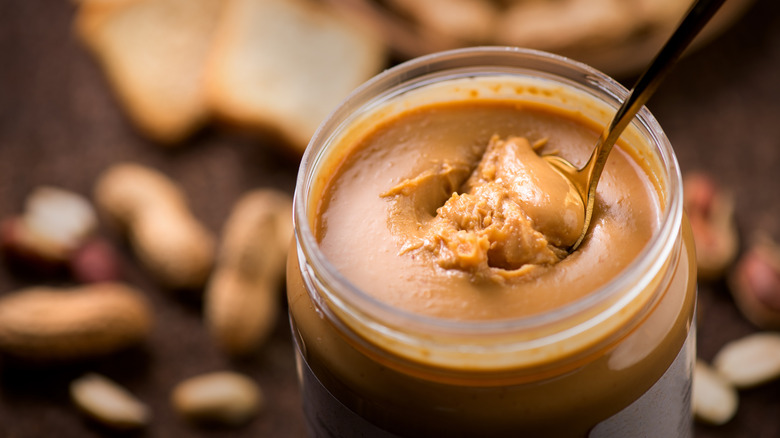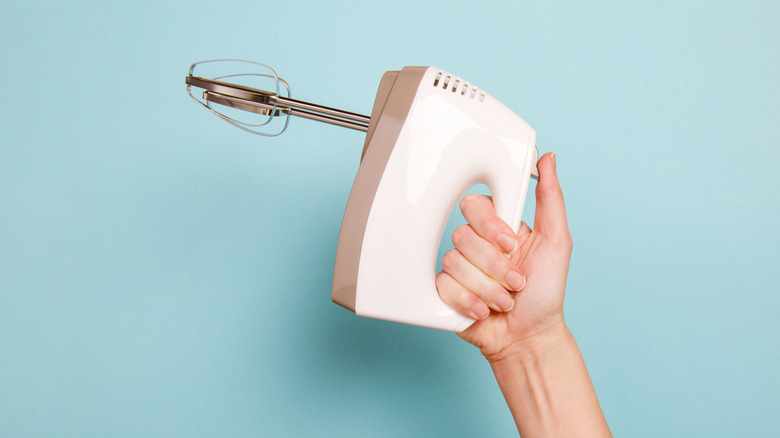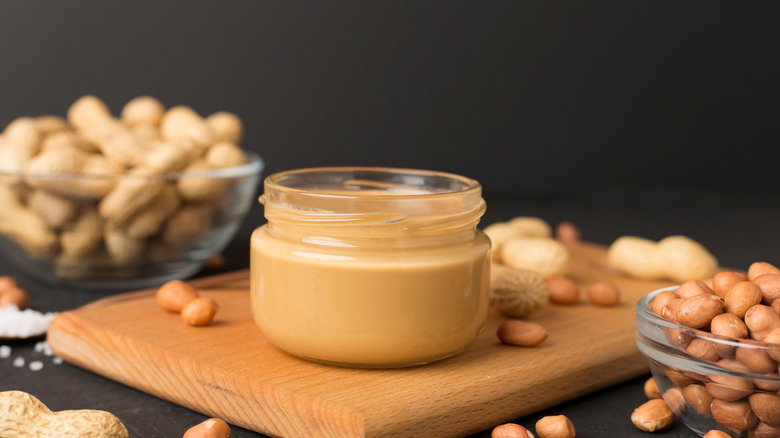The Absolute Best Way To Mix Natural Peanut Butter
We may receive a commission on purchases made from links.
Whenever you spot the word "natural" on a food label, you know you're in for unadulterated flavors and nutrients that nature has to offer in that ingredient. The same goes for natural peanut butter — its nuttiness is on another level with the added advantage that you're not consuming synthetic chemicals every day in PB&J sandwiches, no matter how you elevate them, or peanut sauces or all your other favorite peanut butter recipes. But before you can scoop out some of that natural stuff, how do you stir it to recombine the separated oil layer back into the solid butter without causing a big mess or wasting precious time? The trick is to use an electric hand mixer with only one beater attached.
If you're used to grabbing a knife or a spoon for this mixing process, then you're all too familiar with the annoying oil spillage as you try to dig into and lift that hardened chunk of butter at the bottom. And if you ever reached for a hand blender only to find the head is too big for the size of jar you bought this time, we feel your pain. Maybe you've even used a stand mixer or blender before, but we all know about the dreaded cleanup of utensils afterward. So that's why a hand mixer is the absolute best way to mix natural peanut butter. You only have one small utensil to clean (the single beater), your arm is spared a tiring impromptu workout, and the mixer is quite fast and effective with no messy spills.
How to properly use a hand mixer to stir natural peanut butter
Before even taking out the hand mixer to stir your natural peanut butter, you first need to decide what to do with that oil layer at the top — to drain or not to drain it. If you usually find that your peanut butter feels too runny after stirring, especially the creamy type, then you can pour out that excess oil before mixing. But don't throw it away. Store it to use in some of your stir fry recipes. However, if you don't like a particularly dry consistency in your peanut butter, then leave the oil in the jar so you can incorporate it back into the nut butter.
Now take your hand mixer – one of our favorites is the KitchenAid 5-speed ultra power hand mixer — and attach only one beater. With the mixer still off, dip the beater into the jar and push it to the very bottom. Now hold the jar firmly with your other hand, and turn on the hand mixer at the lowest speed. You don't want your jar flying around and causing an oily mess, so hold on tight. Slowly move the beater up and down and around the jar as it stirs. Once the butter has recombined with the oil, gradually increase the mixer speed for a more thorough mixing. And there you have it — your well-mixed natural peanut butter with minimal stress or mess.
Why natural peanut butter separates in the first place and how to prevent it
If you're a regular user of natural peanut butter, that oil layer at the top of the jar probably doesn't surprise you because you're used to seeing it, even expecting it. However, some novice users may wonder whether that's a normal occurrence or something to steer clear of. The good news is that this is a completely natural phenomenon. The separated peanut butter is safe to eat, but you'll need to stir it first for the best experience. So what causes this separation in the first place?
As we mentioned above, natural peanut butter doesn't contain any additives or chemicals. Most peanut butter brands in this "natural" category are made of pure peanuts, like Crazy Richard's 100% all-natural creamy peanut butter, or just peanuts and salt, like Smucker's natural creamy peanut butter. That means they lack added stabilizers like hydrogenated oil meant to keep nut butter combined and prevent the oil from separating from the solids.
Now, even though natural peanut butter is bound to separate, there is one trick that can keep it combined after stirring: store the peanut butter in the refrigerator. Because of the chilly temperatures, the oil will congeal and therefore slow down the rate of separation. However, be warned that nut butter stored in the fridge will firm up and is likely to be harder to use if you need to spread it on, say, a sandwich.


